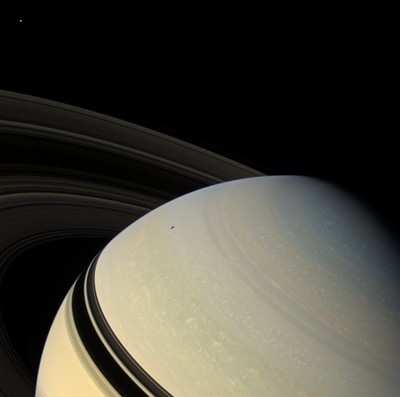Water, Ammonia May Lie Under Surface Of Saturnian Moon
Data collected during several recent flybys of Titan by NASA's
Cassini spacecraft have put another arrow in the quiver of
scientists who think the Saturnian moon contains active
cryovolcanoes spewing a super-chilled liquid into its atmosphere.
The information was released Monday during a meeting of the
American Geophysical Union in San Francisco, CA.

"Cryovolcanoes are some of the most intriguing features in the
solar system," said Rosaly Lopes, a Cassini radar team
investigation scientist from NASA's Jet Propulsion Laboratory in
Pasadena. "To put them in perspective -- if Mount Vesuvius had been
a cryovolcano, its lava would have frozen the residents of
Pompeii."
Rather than erupting molten rock, it is theorized the
cryovolcanoes of Titan would erupt volatiles such as water, ammonia
and methane. Scientists have suspected cryovolcanoes might inhabit
Titan, and the Cassini mission has collected data on several
previous passes of the moon that suggest their existence. Imagery
of the moon has included a suspect haze hovering over flow-like
surface formations. Scientists point to these as signs of
cryovolcanism there.
"Cassini data have raised the possibility that Titan's surface
is active," said Jonathan Lunine, a Cassini interdisciplinary
scientist from the Lunar and Planetary Laboratory, University of
Arizona, Tucson. "This is based on evidence that changes have
occurred on the surface of Titan, between flybys of Cassini, in
regions where radar images suggest a kind of volcanism has taken
place."

What led some Cassini scientists to believe that things are
happening now were changes in brightness and reflectance detected
at two separate and distinct regions of Titan. Reflectance is the
ratio of light that radiates onto a surface to the amount reflected
back. These changes were documented by Visible and Infrared Mapping
Spectrometer data collected on Titan flybys from July 2004 to March
2006.
In one of the two regions, the reflectance of the surface surged
upward and remained higher than expected. In the other region, the
reflectance shot up but then trended downward. There is also
evidence that ammonia frost is present at one of the two changing
sites. The ammonia was evident only at times when the region was
inferred to be active.
"Ammonia is widely believed to be present only beneath the
surface of Titan," said Robert M. Nelson of JPL, a scientist for
Cassini's Visual and Infrared Mapping Spectrometer team. "The fact
that we found it appearing at times when the surface brightened
strongly suggests that material was being transported from Titan's
interior to its surface."

Some Cassini scientists indicate that such volcanism could
release methane from Titan's interior, which explains Titan's
seemingly continuous supply of fresh methane. Without
replenishment, scientists say, Titan's original atmospheric methane
should have been exhausted long ago.
But other scientists familiar with the spectrometer data argue
that the ammonia identification is not certain, and that the
purported brightness changes might not be associated with changes
on Titan's surface. Instead they might result from the transient
appearances of ground "fogs" of ethane droplets very near Titan's
surface, driven by atmospheric rather than geophysical processes.
Nelson has considered the ground fog option, stating, "There
remains the possibility that the effect is caused by a local fog,
but if so, we would expect it to change in size over time due to
wind activity, which is not what we see."
The chilly volcanoes of Titan are not a fait accompli. An
alternative hypothesis to an active Titan suggests the Saturnian
moon could be taking its landform evolution cues from a moon of
Jupiter.

"Like Callisto, Titan may have formed as a relatively cold body,
and may have never undergone enough tidal heating for volcanism to
occur," said Jeffrey Moore, a planetary geologist at the NASA Ames
Research Center, Moffett Field, CA. "The flow-like features we see
on the surface may just be icy debris that has been lubricated by
methane rain and transported downslope into sinuous piles like
mudflows."
More revelations may be forthcoming. Scientists are still
analyzing the data from Cassini's most recent flyby on Dec. 5.
Cassini's next Titan flyby is scheduled in 11 days, when the
spacecraft will come within 970 kilometers (603 miles) of its
cloud-shrouded surface.
 ANN's Daily Aero-Term (04.24.24): Runway Lead-in Light System
ANN's Daily Aero-Term (04.24.24): Runway Lead-in Light System ANN's Daily Aero-Linx (04.24.24)
ANN's Daily Aero-Linx (04.24.24) Aero-FAQ: Dave Juwel's Aviation Marketing Stories -- ITBOA BNITBOB
Aero-FAQ: Dave Juwel's Aviation Marketing Stories -- ITBOA BNITBOB Classic Aero-TV: Best Seat in The House -- 'Inside' The AeroShell Aerobatic Team
Classic Aero-TV: Best Seat in The House -- 'Inside' The AeroShell Aerobatic Team Airborne Affordable Flyers 04.18.24: CarbonCub UL, Fisher, Affordable Flyer Expo
Airborne Affordable Flyers 04.18.24: CarbonCub UL, Fisher, Affordable Flyer Expo






